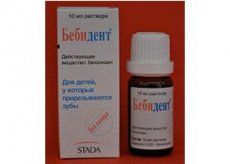Medical expert of the article
New publications
Preparations
Bebident
Last reviewed: 03.07.2025

All iLive content is medically reviewed or fact checked to ensure as much factual accuracy as possible.
We have strict sourcing guidelines and only link to reputable media sites, academic research institutions and, whenever possible, medically peer reviewed studies. Note that the numbers in parentheses ([1], [2], etc.) are clickable links to these studies.
If you feel that any of our content is inaccurate, out-of-date, or otherwise questionable, please select it and press Ctrl + Enter.

Bebident is an anesthetic for surface anesthesia. The drug is used in dentistry and ENT practice, as it has a local anesthetic effect. International and chemical name: benzocaine, 4-aminobenzoic acid ethyl ester. The substance has an ester structure, when applied locally, it reduces the excitability of pain receptors and the conductivity of nerve fibers. Reduces pain, temperature and tactile sensitivity. Affects nerve fibers that conduct sympathetic, pain and postganglionic fibers. Reduces membrane permeability for sodium and potassium ions, reducing the level of excitability of nerve fibers.
Indications Bebident
The medicine is prescribed to pediatric patients to eliminate the pain syndrome that occurs during teething. According to the indications for use, Bebident can be used in both dental and ENT practice.
 [ 1 ]
[ 1 ]
Release form
The drug is available as a solution. Bebident is available in 10 ml bottles in cardboard packaging. The liquid is transparent or yellowish with a syrup consistency and chamomile aroma.
1 ml of the medicine contains: 3 mg benzocaine, ethanol 96%, chamomile flavoring, sorbitol, potassium dihydrogen phosphate, purified water and sodium monohydrogen phosphate. To prevent tooth damage, sorbitol is used - a sugar substitute that does not cause caries.
Pharmacodynamics
Bebident blocks the excitability of the membranes of nerve endings. The pharmacodynamics of benzocaine indicate its anesthetic properties. It affects the threshold of perception of sensitive receptors that suppress and transmit painful impulses. Getting on the mucous membranes, the medicine reduces sensitivity: the perception of hot and cold, physical impact.
A pronounced reaction is observed when acting on sympathetic postganglionic and pain fibers. The active substance reduces membrane permeability and the level of irritation of nerve fibers.
Pharmacokinetics
After application to the oral mucosa, the medication has an analgesic effect on the gums and teeth. Pharmacokinetics Bebident is characterized by low absorption and hydrolysis into ethanol and p-aminobenzoic acid.
The anesthetic effect develops quickly and lasts for several hours. The active substances of the solution are absorbed on the surface of nerve fibers, weakening their sensitivity when exposed to various irritants.
Dosing and administration
Since Bebident is used to treat children, the method of application and dosage should be prescribed by a doctor. The product is intended for external use. 1-2 drops of the solution are applied to the gums with a cotton swab using massage movements. The procedure is carried out up to 3 times a day.
As a rule, the solution is used until the baby teeth have completely erupted and until the permanent teeth appear.
Use Bebident during pregnancy
Since local anesthetic is intended for the treatment of pediatric patients, its use during pregnancy is not advisable. For oral anesthesia during pregnancy and lactation, women are prescribed safe means. Such medications do not penetrate the systemic bloodstream and do not pass through the placental barrier.
Side effects Bebident
If Bebident is used on serious wound surfaces, it may provoke an increase in methemoglobin in the blood and the associated deterioration of oxygen transport.
Most often, side effects manifest themselves in the form of allergic reactions: urticaria, swelling, bronchospasms, anaphylactic shock.
Overdose
If the dose prescribed by the doctor is not followed, overdose symptoms appear. Most often, adverse symptoms manifest as increased side effects: urticaria, swelling, bronchospasms, anaphylactic reactions.
Treatment of overdose is symptomatic and requires discontinuation of the drug.
 [ 22 ]
[ 22 ]
Interactions with other drugs
To relieve pain during teething in children, pediatricians prescribe special solutions, drops and ointments. To achieve a therapeutic effect, several products can be used simultaneously.
The interaction of Bebident with other drugs depends on the age of the child. It is not recommended to use several local anesthetics, as this can provoke severe allergic reactions. It is permissible to use drugs of different release forms.
 [ 23 ], [ 24 ], [ 25 ], [ 26 ], [ 27 ], [ 28 ], [ 29 ], [ 30 ]
[ 23 ], [ 24 ], [ 25 ], [ 26 ], [ 27 ], [ 28 ], [ 29 ], [ 30 ]
Storage conditions
The local anesthetic solution must be kept in a place protected from direct sunlight and moisture. According to storage conditions, the temperature should not exceed 25°C. If these recommendations are not followed, the medication loses its physicochemical and pharmacological properties.
Attention!
To simplify the perception of information, this instruction for use of the drug "Bebident" translated and presented in a special form on the basis of the official instructions for medical use of the drug. Before use read the annotation that came directly to medicines.
Description provided for informational purposes and is not a guide to self-healing. The need for this drug, the purpose of the treatment regimen, methods and dose of the drug is determined solely by the attending physician. Self-medication is dangerous for your health.

